Usefulness of phase angle on bioelectrical impedance analysis as a surveillance tool for postoperative infection in critically ill patients
- PMID: 36910475
- PMCID: PMC9992789
- DOI: 10.3389/fmed.2023.1111727
Usefulness of phase angle on bioelectrical impedance analysis as a surveillance tool for postoperative infection in critically ill patients
Abstract
Purpose: Bioelectrical impedance analysis (BIA) has advantages of obtaining results quickly, safely, reproducibly, and non-invasively. Phase angle (PhA) is one of the parameter of BIA, its values represent the permeability or integrity of cell membrane. With the exception of C-reactive protein (CRP), few studies have estimated an association between PhA and these conventional biomarkers. Herein, we aimed to investigate the association between the PhA value and the conventional inflammatory markers in postoperative patients in intensive care unit (ICU). Also, the correlation between the change in PhA and the occurrence of infectious complication were determined.
Methods: From July 2020 to February 2022, retrospective observation study conducted in 221 patients who admitted to ICU after abdominal surgery. BIA measurements and blood sampling were routinely performed the next morning. The relationship between PhA and the inflammatory markers were assessed after adjusting for age and body mass index. Univariate and multivariate logistic regression analysis was performed to examine the predisposing factors for postoperative infections.
Results: Among 221 patients admitted to ICU after abdominal surgery, infectious complications occurred in 62 cases. CRP, procalcitonin, or presepsin levels were negatively correlated with PhA in both gender. (-0.295, -0.198 or -0.212 of partial correlation coefficients, respectively in males, and 0.313, -0.245 or -0.36 of partial correlation coefficients, respectively in females) But, white blood cell did not show significant association with PhA in both genders. For males, increased level of CRP on postoperative day 1 (POD1) was revealed as the significant predicting factor for postoperative infectious complication [odds ratio (OR): 1.184, 95% confidence interval (CI): 1.090-1.285, p < 0.001]. For females, increased Acute Physiology and Chronic Health Evaluation II score at admission (OR: 1.457, 95% CI: 1.068-1.987, p = 0.018), increased level of presepsin on (OR: 1.003, 95% CI: 1.001-1.006, p = 0.016) and decreased value of PhA on POD1 (OR: 0.980, 95% CI: 0.967-0.993, p = 0.003) were revealed as the significant predicting factors.
Conclusion: Phase angle obtained through BIA can be used as a predictor of infection as it shows a significant association with inflammatory markers. Phase angle measurements through BIA could improve patient prognosis after abdominal surgery through the careful observation of infections and early, appropriate treatment.
Keywords: infection; inflammatory marker; intensive care unit; phase angle; surgery.
Copyright © 2023 Lee and Kim.
Conflict of interest statement
The authors declare that the research was conducted in the absence of any commercial or financial relationships that could be construed as a potential conflict of interest.
Figures




References
-
- Pessaux P, Msika S, Atalla D, Hay JM, Flamant Y. Risk factors for postoperative infectious complications in noncolorectal abdominal surgery: a multivariate analysis based on a prospective multicenter study of 4718 patients. Arch Surg. (2003) 138:314–24. doi: 10.1001/archsurg.138.3.314, PMID: - DOI - PubMed
LinkOut - more resources
Full Text Sources
Research Materials
Miscellaneous

